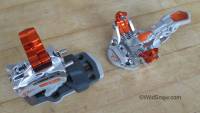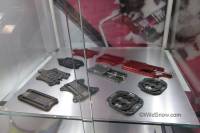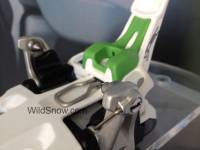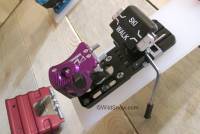Snazzy websites drop like silver rain in web designer heaven. Polished anodized aluminum and masculine black carbon plastic beg the shopper fondle. Ski touring binding prices seem to have stabilized and in our opinion offer good values. Time for the tech binding war of winter 2015-16.
After a frustrating series of binding defects these past seasons, we’re thinking most major ski touring “frameless*” binding models won’t be presenting annoying glitches or downright self destructing this year. Perhaps we won’t even see a product recall (informal or official). Miracles do happen. Thus, all players are fully weaponized and ready to rock.
Will it indeed be the “winter of the backcountry bindings?” We think yes. Prepare to be amused, even delighted — and end up with some truly nice clamps if you’re shopping. (Also, the market is obviously over-saturated, bindings such as G3 Onyx and Dynafit Radical are already discounted and we expect to see many more such deals after Q4 sifts out the casualties from the winners.)
Here is the rundown of what machinery we feel are the major tech* binding players, in alpha order by brand. These are “ski touring” bindings. To simplify we’ve left out most free touring and skimo outliers such as Dynafit Beast and ATK Revolution.
ATK Race Is always an interesting visit at ISPO. Though these virtual jewel pieces have gained a reputation of functional durability, ATK has not penetrated the North American market to any significant degree. Nonetheless, we’re global here at WildSnow so we include. At the trade mega-fair every year in Munich, what’s interesting at ATK is Giovanni bringing out his platter of Italian antipasti along with compatible libations. One does wonder how the guy survives ISPO after nipping all day, every day. But Italians do have a way of getting it done. Lesson learned.
In terms of ATK bobbles that are WildSnow dot com compatible, don’t count on the ATK website. As an in-your-face affront to every known principle of internet marketing, Giovanni (good for him) shut down his website with only a splash page until later this month, when he announces all the new stuff for 2016. Meanwhile, however, for mounting race bindings on touring skis we’re still fans of the ATK SL World Cup. At 114 grams with years of refinement, this is a popular binding for doing the “small binding on big ski” style getup we’ve observed worldwide.
Caveats, as with any tech binding configured with aluminum toe wings/arms, later model is best as such parts were sometimes under-engineered back in the day. In other words, I’d not advise buying used aluminum “race” bindings any more than I’d advise buying used tires for European autobahn driving. Bear in mind that the ATK World Cup offerings do not have adjustable release values. The regular (men’s) version is said to be very stiff, perhaps even to the point of having no really functional safety release for normal sized to smaller skiers. The women’s version is said to offer “50% softer” release and in my opinion might actually be much safer for smaller skiers of either gender.
The standard ATK ski touring binding is their RT model. We tend to skip that guy and jump to their free touring options in Raider 12 and 14. Those have optional brakes, three-position heel lifts (RT has an add-on heel lift) and other features that compete in the main ski-touring category. In other words, don’t let the “Free” nomer fool you, these bindings do it all. The 14 offers an extra wide base and screw pattern (60 mm compared to classic <>30 mm pattern). At 330 and 350 grams respectfully, good in the mass department.
Shopping for ATK can be a challenge. Perhaps the easiest way to acquire in North America (provided you want the low mass ATK version) is go for the rebranded Hagan ZR, which is an ATK SL World Cup. Check both Skimo and Cripple Creek for availability.
Are we Dynafit biased, or is Dynafit biased to WildSnow.com? Face it, Dynafit is still the only 100% vertical ski touring brand out there. In other words, they sell their own designed and branded boots, bindings, skis and everything in between–even your summer shorts. The only important items they don’t sell are food, beacons and avalanche airbag packs. I’ve heard they’re working on all three.
So, Dynafit is WildSnow.com biased (yes Virginia, we end up blogging about them fairly often, any other questions?). Highpoints of Dynafit bindings this year: The now classic Radical series bindings receive a price drop, but more importantly we’re fairly sure they’ll receive stronger screws holding the top-plate on the heel (breakage in this area is a known issue, though as far as I can tell has not reached recall levels and we’re still not sure if stronger screws will be “officially” offered in an upgrade kit.) Radical 2.0 will no doubt be pushed, and the Superlight 2.0 is so cool that here in Colorado we’d smoke it.
We like the beefed 2.0 Radical heel unit but we still wonder if the rotating toe piece is truly necessary for most ski touring. Time will tell. We’ve had both bindings in play now for some time with zero issues.
Personally, I prefer the non-rotating toe of most tech bindings simply because it has slightly less fiddle factor and with a light touch you may be able to tour in avalanche terrain with the toe unlatched. With a rotating toe, latching/locking is mandatory in tour mode. Yet the rotating toe does make for a smoother and more consistent lateral release, especially since boot toe fittings can never be perfectly identical. With a non-rotating tech binding toe, the interface of binding pins and boot fittings controls smoothness and consistency of lateral release. We’ve seen many situations where the boot fittings were so out of spec the binding had virtually no safety release — rotating toe prevents that problem. Single Radical with 100mm brake: original ST is 566 grams; 2.0 is 642 grams.
So dear readers, where is the WildSnow sweet spot in the extensive Dynafit ski touring binding lineup? We’ll go retro with Radical ST 1.0, Speed Radical (assuming all Radicals are upgraded with stronger rear plate screws) or the smokable (will I eat my words?) Superlight 2.0. Yet don’t ignore Radical 2.0.
Fritschi Vipec will continue offering side release at the toe and a solid heel hold you can feel while skiing. Fritschi’s trial with Vipec was their clever but problematic adjustable toe pin depth. That got taken care of last season by a physical locking system that 100% locks out any possibility of loosening. If you’re a trad alpiner and have to have side release at the toe, these are your grabbers.
Only issue with Vipec we deem important is they’re still tricky to clip into, so while being alpine-like in release they are very un-alpine-like in terms of quickly snapping on your feet and following your friends to the ski lift after you’ve had lunch. This is another binding we feel comes close to being both a frontcountry and backcountry “do it all” grabber. Diamir Vipec weight is a WildSnow verified 616 grams, single 2015-2016 binding with screws and 100mm brake.
Update: As of August 24, 2015 we have heard nothing about whether Fritschi will distribute their improved “black” version Vipec in North America. But it will be available in Europe. We will cover here as information rolls in. Comments appreciated.
Shop for Fritschi Diamir Vipec.

G3 ION tech backcountry skiing binding, copy of the standard tech binding with enough added features to set it apart.
G3 ION has not been immune to issues that cause us to wonder if all tech bindings have been hexed by a coven of scraggly telemarkers dancing around a bonfire at the mouth of the their straw lined snowcave (who needs a sleeping bag!?). At first, the coven loved G3 because G3 was all tele, all the time. Then G3 went AT in 2009, beginning their ski touring tech binding epic with an effort known as the Onyx. That’s when the telestic telemarkers directed their vibes at the threat that tech bindings made to their way of life. Perhaps Onyx was their victim.
Well, the telecoven disbanded when G3 engineers burned the correct incense (the fluoro version is particularly effective) and chanted a few mantras, which revealed to them all bugs in the Onyx, which were subsequently fixed (though in our opinion it’s still one of the more difficult tech bindings for novices to clip into). With their newfound clarity of mind and spirit, G3 then turned to making an improved version of the classic frameless tech binding, which came to be called ION and is indeed one of our favorites.
ION comes in three versions this winter: ION 10 is the sweet spot as a ski touring binding; ION 12 gives you release value that goes past eleven so you too can have a binding that exceeds the strength of your knee ligaments and leg bones, and the brake-less LT 12 kinda’ mixes both worlds and is our favorite of the line for a full-on ski touring rig, as we tend to go without ski brakes.
Downsides? Up to now we’re still hearing occasional reports of ION brakes not staying latched down in touring mode. We’re certain this will eventually become a non-issue with small in-line improvements as well as user education. But we had to mention as we’ve had this happen with retail version test bindings. Main upsides? These guys are durable, and have possibly best-in-class toe retention that allows average weight light-touch skiers to tour without latching the toes (useful in avalanche terrain). The flipping heel lifts are just plain flippin’ great.
ION LT12 single binding 476 grams (16.9 ounces), ION 10/12 with brake 585 grams. Shop for G3 ION, in stock soon.
Perhaps Marker Kingpin also received astral waves from the Targhee coven, as somehow their first retail bindings had an assembly problem that resulted in the toe pins loosening. To Marker’s credit, they fixed the problem about as fast as humanly possible and the Kingpin is ready for war.
Kingpin challenges our definition of a “tech” binding as the heel unit does not require an embedded boot fitting. Conversely, if your boot does _not_ have an industry standard shaped heel area (e.g. “short” boots such as Atomic Backland) you have to install a heel adapter. In my view that’s not an issue, as it’s silly to pair light touring shoes with what is essentially a freeride binding. Still, you might end up needing to use lighter boots with Kingpin (I raise my hand), so it is thoughtful on the part of Marker to supply an adapter.
Downsides of Kingpin is they’re heavy for the ski touring category (730 grams, one binding with brake), and the folding heel lifters are fiddly (I found them difficult to flip with a soft pole basket, and hate having to flip my pole upside down to operate bindings). Upside is these boys yield a SOLID feel in downhill mode that’s no different than you get from an alpine binding.
Kingpan has what appear to be strong toe springs; the “Six Pack” of six instead of four springs inspires confidence. Several engineers told me the same thing could have been accomplished with 4 stronger springs, at less weight. I have faith in Marker and figure they had good reason to go with six, beyond cosmetics. Nonetheless, we’ve tested tech binding toe springs and the strength of the Kingpin toe is only average. It’s thus somewhat of a mystery why they would add weight without adding more spring “pressure.” Perhaps that’s too much information…beyond bench testing, does it ski? Quite a few excellent skiers have pushed the binding, and the answer seems to be yes. Put succinctly, Kingpin is easily the binding that defies categorization. It’s a touring binding. It slices. It’s a freeride binding. It dices! It’s a sidecountry binding. It rocks!
Shopper’s note: The Kingpin 10 toe springs are now apparently grey colored, while the model 13 springs are black (though we’ve seen some model 10s out there with the black springs). According to our tests the black springs are indeed stronger. If you’re choosing between two “DIN” versions of the same binding, it’s wise to purchase the version with stronger toe springs even if you don’t need the higher release value settings. In other words, when shopping for Kingpin you may only need release value 8, but you ski aggressively so get added confidence from using the model 13 stronger toe springs.
Marker Kingpin Ski Touring Binding available here..
Plum ski touring target binding is still the Guide with nice combo of durability and mono-machine appearance. Downsides: Finicky boot length adjustment track, prone to damage while loosening and tightening. At ISPO we saw better Plum brakes that have made it to retail distribution. One version of the brake is integrated with the bindings, and they’re making another version that operates independent of the binding and could possibly be a nice aftermarket stopper for other bindings. According to our scale, Plum Guide is 358 grams per binding, without screws or brake. Plum also sells numerous “Yak” models, virtually the same thing as a Guide only with wider footprint, significantly stronger toe springs and a few accessories.
Shop for Plum ski bindings at Backcountry.com. or at our partner Cripple Creek Backcountry.
*We define “tech” “frameless” bindings as those that at least use the de facto industry standard toe fittings invented by Fritz Barthel and promulgated by Dynafit. An example of a “frameless” binding we would not call a tech binding would be the Trab TR2. These are not “official” definitions, just our working verbiage here at WildSnow.
WildSnow.com publisher emeritus and founder Lou (Louis Dawson) has a 50+ years career in climbing, backcountry skiing and ski mountaineering. He was the first person in history to ski down all 54 Colorado 14,000-foot peaks, has authored numerous books about about backcountry skiing, and has skied from the summit of Denali in Alaska, North America’s highest mountain.






